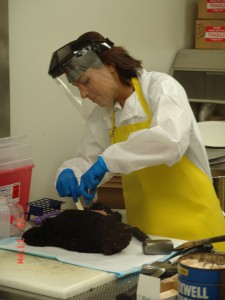 Some of our Laboratory scientists (Kathryn Fitzpatrick, Alexandra Bhatti, Heather Bickley and Charles Martin) are busy right now testing the brains of the 2 bears that were destroyed over the weekend to see if they had rabies. You might have heard about the bear attacks, which happened in and around Payson recently. On Sunday, a Tempe man was attacked by a bear in his tent in Ponderosa Campground which is about 12 miles E. of Payson on Hwy. 260 (my family camps there every Halloween). Last Friday a bear attacked a guy sleeping in his cabin under construction near Payson. Last month a bear attacked a woman also at Ponderosa.
Some of our Laboratory scientists (Kathryn Fitzpatrick, Alexandra Bhatti, Heather Bickley and Charles Martin) are busy right now testing the brains of the 2 bears that were destroyed over the weekend to see if they had rabies. You might have heard about the bear attacks, which happened in and around Payson recently. On Sunday, a Tempe man was attacked by a bear in his tent in Ponderosa Campground which is about 12 miles E. of Payson on Hwy. 260 (my family camps there every Halloween). Last Friday a bear attacked a guy sleeping in his cabin under construction near Payson. Last month a bear attacked a woman also at Ponderosa.
It’s important to know if the bears were infected because if they were, then the people that were attacked definitely need a rabies vaccine and immunoglobulin. If the bears don’t have rabies then the patients don’t need the vaccine. Rabies is pretty much 100% fatal if an exposed person doesn’t get a vaccine in time. Also, by testing the DNA from the saliva etc. from the bears and matching it to the residue left after the attacks, we can tell whether Fish & Game got the right bears. By the way- if you’re my age, you might think that the rabies vaccine and immunoglobulin is a series of shots with real long needles in the stomach. It is a series of shots- but it’s not in the stomach anymore (but the immunoglobulin is real expensive- about $10K).
Here’s how the lab test works. We get the heads of the animal from Fish & Game and our team of scientists extract the brain tissue. We use what’s called a fluorescent antibody stain on the brain tissue to see if the antibodies latch onto rabies viruses. If they latch on- the antibodies “light up” and our lab scientists can confirm under a microscope that the rabies virus was in the brain tissue. We’ll have results by morning.
By the way- it would be rare for a bear to be infected with rabies because they’re not a common “reservoir” like foxes or bats. But it can happen- especially if a rabid fox attacked the bear awhile back.









